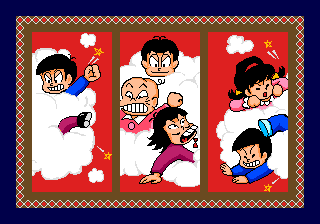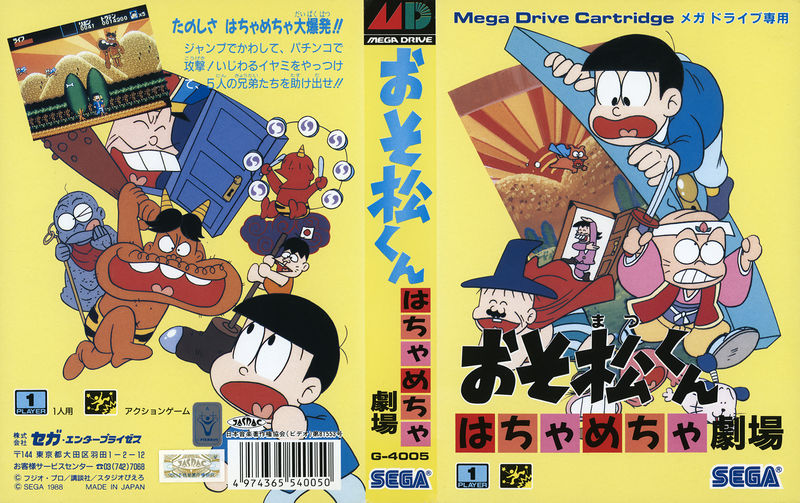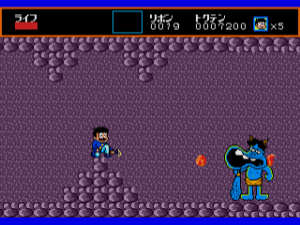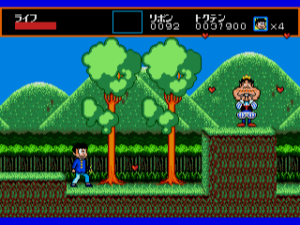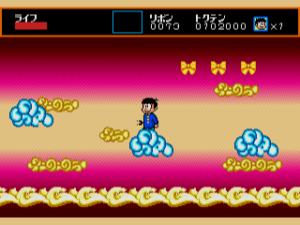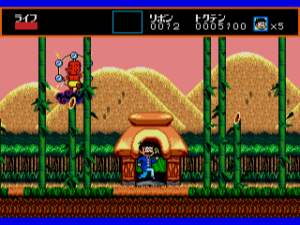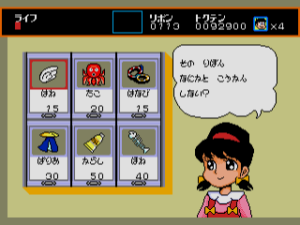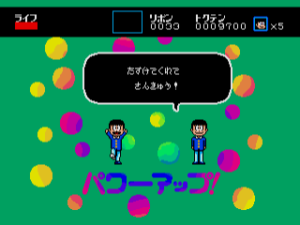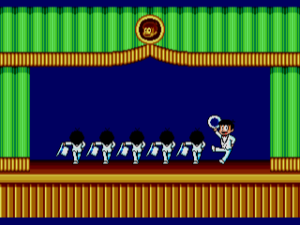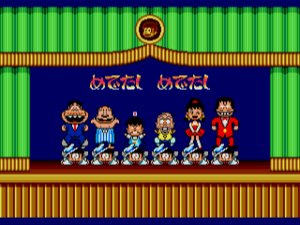With the good comes the bad, I suppose…
So hey, I just wrote an anime review about Osomatsu-san, the recent reboot of a classic gag manga/anime that was a massive hit overseas. Remember how I mentioned that there were two Osomatsu-kun anime series before it, one from 1966 and another from 1988? Well, as you might already know, 1988 was the launch year of the Sega Megadrive in Japan. The console launched in October of that year with Space Harrier II and Super Thunder Blade, impressive renditions of popular arcade titles, while a very faithful port of Juuouki/Altered Beast followed soon after in November. But here’s a factoid for you: the fourth-ever Megadrive game, released a little under two months after the console’s debut, was a licensed game based on Osomatsu-kun.
Titled Osomatsu-kun: Hachamecha Gekijou (“Nonsense Theatre”), the game features a bunch of familiar series characters: the Matsuno brothers, Totoko, Chibita, Iyami, Hatabou, and so on – in new and bizarre roles in a strange-as-hell series of fantasy settings.
It’s also an astounding pile of garbage. And I played all of it.
Like many licensed games of this era, Osomatsu-kun: Hachamecha Gekijou (look, I’ll just call it “Osomatsu-kun” from this point on, cool?) is a side-scrolling action platformer. Playing as Osomatsu, you and your trusty slingshot must venture through a series of ~*wacky*~ stages in order to rescue your five siblings from Iyami and Chibita, who have kidnapped them because of reasons. The hazards throughout the levels consist of enemies modeled after series characters (and a few odd cameos from Akatsuka’s other manga series). That’s where any resemblance to good, logical platform game design ends.
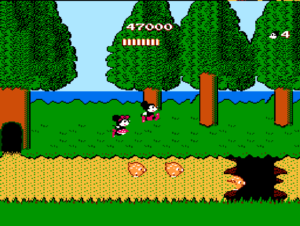 Let me digress a bit here. One of the games from my youth I look back on and say “holy hell, how did I ever finish that?” is Mickey Mousecapade. It was Capcom’s first NES Disney game, though it was actually Hudson who developed it. It’s a game filled with Famicom Design Logic of the worst kind: hidden stuff crucial to completing maze levels in random places you can only find by shooting everywhere, bosses with near-unavoidable attack patterns you have to tank out, and far too much looping and backtracking resulting in you getting stuck.. Sometimes this sort of weird, old-fashioned “let’s toss random stuff in the game just because” design is endearing, but Mickey Mousecapade offers few hints to finding hidden things and all manner of cheap hits and badly designed hazards to infuriate you.
Let me digress a bit here. One of the games from my youth I look back on and say “holy hell, how did I ever finish that?” is Mickey Mousecapade. It was Capcom’s first NES Disney game, though it was actually Hudson who developed it. It’s a game filled with Famicom Design Logic of the worst kind: hidden stuff crucial to completing maze levels in random places you can only find by shooting everywhere, bosses with near-unavoidable attack patterns you have to tank out, and far too much looping and backtracking resulting in you getting stuck.. Sometimes this sort of weird, old-fashioned “let’s toss random stuff in the game just because” design is endearing, but Mickey Mousecapade offers few hints to finding hidden things and all manner of cheap hits and badly designed hazards to infuriate you.
Why do I bring this up? Because I was constantly reminded of Mickey Mousecapade’s bullshit design choices when playing Osomatsu-kun. It commits many of the same sins. Only Osomatsu-kun is somehow worse.
You start in a stage that’s clearly modeled after historical Japan, with probably-looked-nice for-the-time rising sun background and lots of misshapen yokai and monsters trying to get up in your face. The first thing you’ll notice, besides the sound effects and music being “stock_megadrive_SFX.wav,” is that your slingshot weapon’s range is awful. It extends just a few tiles in front of you, making you get uncomfortably close to enemies in order to shoot them.. Don’t worry, that’ll get fixed eventually, but before that you’re going to have to find the first two hostage Matsunos. So you make your way up to the end of the level, perhaps ducking in a door or two along the way to see what’s there, and then when you reach the end of the stage… you’re dumped back someplace earlier in the stage.
Yep, the game doesn’t tell you this, but it’s actually a maze. A really, really badly designed maze. Those doors you entered beforehand? Yeah, they’re part of the maze and put you in different locations, though it’s often hard to tell what section of the stage you’re in because everything looks very similar, save for the sky areas and the underground.
Actually, you might have figured out that these stages are mazes if you were unlucky enough to stumble down a pit. Mercifully, pits in Osomatsu-kun don’t kill you. Instead, you wind up in an incredibly ugly underground area filled with enemies and a mono-colored background. There is one of these for every pit in the game. Sometimes there are even pits-in-pits that lead to different pit areas, and sometimes there are clouds, balloons, and flying turtles that take you back to somewhere random on the surface. Sometimes those clouds also appear on the surface and take you to bonus areas in the sky, which plop you back down in a random surface location when you fall from them, except for the times when you fall into a weird water-ish area for unknown reasons, which usually leads to more pits. Did you catch all that?
What happens is that you wind up stumbling through areas over and over again, most of which look very similar, hoping that you stumble into the right sequence of doors or pits or flying warps or whatever to take you to the next stage. If you’re lucky, you might chance upon Totoko’s shop, where you can play a bonus game or buy potentially helpful items by exchanging ribbons. (It’s worth noting that the Japanese font in the bonus/store scenes is surprisingly hard to read — I thought I had issues because I’m not a native speaker, but even Japanese players have noted how confusing a lot of the characters look.) The usefulness of the items is pretty limited, as you can only carry one of each at a time and their functionality leaves a lot to be desired in most situations — save for the fireworks, which you can do some pretty broken strategies with. You’ll generally have plenty of ribbons, since they replenish every time you revisit an area, which you’ll be doing a lot! Heck, you might even stumble across a hidden bonus area with lots of ribbons through a secret door you reveal by slingshot that you can farm. (Assuming, of course, that the game doesn’t softlock on you in one of these rooms, which happened to me once when the exit wouldn’t trigger.)
If you wander enough, you may eventually stumble into the path that leads you to a boss fight. Bosses in this game are piss-easy for two reasons: their patterns are ultra-simplistic and easy to avoid, and even if you die you respawn almost immediately in the same place. This makes even the “harder” bosses a cinch to tank through. There are two bosses per stage, so you need to find them both and rescue your bros.
Each Matsuno you rescue give you a permanent power boost to damage, range, or life, which you can check on the pause screen. By the time you reach Stage 2, your slingshot will have gone from “arm’s length” to “basically the whole screen.” Game balance! But even powering up your weapon doesn’t always help with some of the sequences where hits become unavoidable. Eventually, the seemingly endless cycle of “where the hell am I even going” will wear down Osomatsu’s lives. There are no continues, so I hope you remembered how you found everything the last time through, because you’ll need to do it all again!
But if you’re really, truly devoted to plumping the depths of how miserable Osomatsu-kun can be, you’ll keep at it. You’ll eventually hit stage two, which has a fairytale theme, and then stage 3, which looks like it was mistakenly transplanted from one of the Flintstones NES games. Stumble your way through that, and—
That’s it! Only three stages! On one hand, your suffering has come to an unexpectedly speedy end. On the other hand, can you imagine having bought this thing in 1988, desperate for games to play on your new Megadrive, only to get a whopping three stages’ worth of content that’s not replayable in the slightest?
In fact, Osomatsu-kun is incredibly fast if you play it correctly. If you know what you’re doing (key word “if”), you can beat the game in under six minutes. Seriously:
So is there any redeeming factor to Osomatsu-kun? Well, I guess Osomatsu’s face changing as his life goes up or down is a nice touch in a game largely devoid of detail, and some of the enemy designs are interesting in a “what were they even thinking” sort of way. The best thing to come out of this title, in my opinion, is an anecdote reprinted on Game Catalog. Many of the staff behind this title went over to Sanritsu/SIMS, where they made much better games. (A theory is that the developers were rushed on this title due to the MD launch and working on SMS Tensai Bakabon at the same time.) As SIMS was being formed, an article in Japan’s Beep! Megadrive magazine mentioned a game where “the original work’s creator stormed into the office and threw ashtrays around.” Urban legend is that they were referring to this title, and the creator in question was Akatsuka, God rest his soul.
In summary, Osomatsu-kun is the exemplary launch window kusoge: likely rushed to launch, exceptionally badly designed in numerous ways, wholly unsatisfying, and embarrassing to everyone involved. Unless you’re hopelessly enamored by gaming garbage like I am, stick with the good stuff. Don’t make Akatsuka’s soul angry again.
